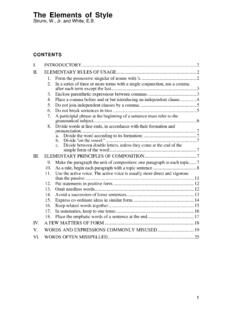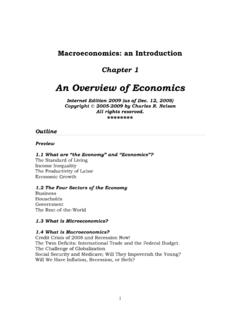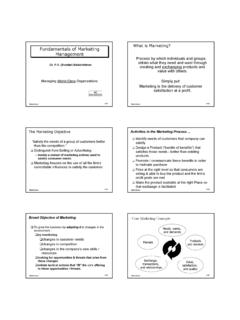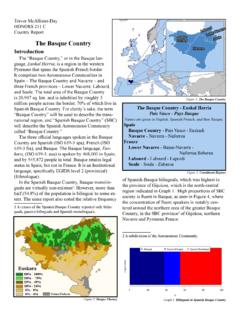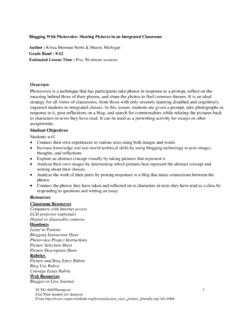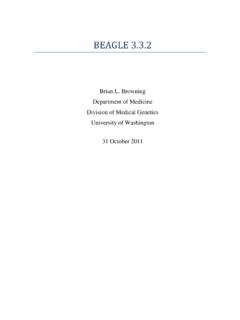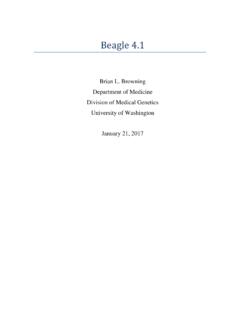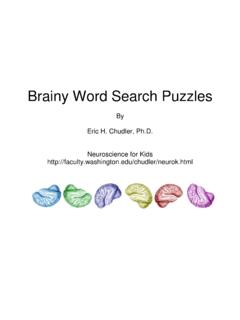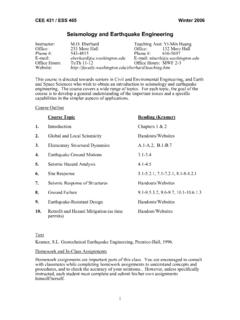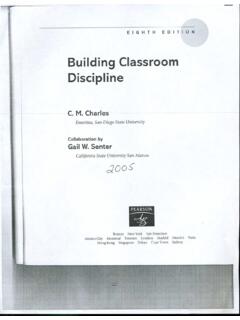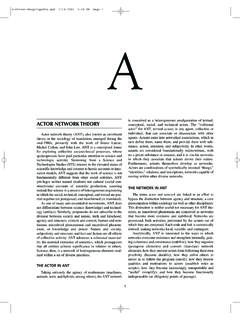Transcription of From Sage on the Stage to Guide on the Side
1 From sage on the Stage to Guide on the SideAuthor(s): Alison KingSource: College Teaching, Vol. 41, No. 1 (Winter, 1993), pp. 30-35 Published by: Taylor & Francis, URL: .Accessed: 24/04/2013 15:15 Your use of the JSTOR archive indicates your acceptance of the Terms & Conditions of Use, available at ..JSTOR is a not-for-profit service that helps scholars, researchers, and students discover, use, and build upon a wide range ofcontent in a trusted digital archive. We use information technology and tools to increase productivity and facilitate new formsof scholarship. For more information about JSTOR, please contact .Taylor & Francis, Ltd. is collaborating with JSTOR to digitize, preserve and extend access to This content downloaded from on Wed, 24 Apr 2013 15:15:07 PMAll use subject to JSTOR Terms and ConditionsFrom sage on the Stage to Guide on the side Alison King In most college classrooms, the pro fessor lectures and the students listen and take notes.
2 The professor is the central figure, the " sage on the Stage ," the one who has the knowledge and transmits that knowledge to the stu dents, who simply memorize the infor mation and later reproduce it on an exam?often without even thinking about it. This model of the teaching learning process, called the transmittal model, assumes that the student's brain is like an empty container into which the professor pours knowledge. In this view of teaching and learning, students are passive learners rather than active ones. Such a view is outdated and will not be effective for the twenty-first century, when individuals will be expected to think for themselves, pose and solve complex problems, and generally pro duce knowledge rather than reproduce it. According to the current constructivist theory of learning, knowledge does not come packaged in books, or journals, or computer disks (or professors' and stu dents' heads) to be transmitted intact from one to another.
3 Those vessels con tain information, not knowledge. Rather, knowledge is a state of under standing and can only exist in the mind of the individual knower; as such, knowledge must be constructed?or re Alison King is an associate professor of edu cation in the College of Education at Cali fornia State University in San Marcos. constructed?by each individual knower through the process of trying to make sense of new information in terms of what that individual already knows. In this constructivist view of learning, stu dents use their own existing knowledge and prior experience to help them under stand the new material; in particular, they generate relationships between and among the new ideas and between the new material and information already in memory (see also Brown, Bransford, Ferrara, and Campione 1983; Wittrock 1990). When students are engaged in actively processing information by reconstructing that information in such new and per sonally meaningful ways, they are far more likely to remember it and apply it in new situations.
4 This approach to learning is consistent with information processing theories ( , Mayer 1984), which argue that reformulating given in formation or generating new informa tion based on what is provided helps one build extensive cognitive structures that connect the new ideas and link them to what is already known. According to this view, creating such elaborated memory structures aids understanding of the new material and makes it easier to remember. In contrast to the transmittal model il lustrated by the classroom lecture-note taking scenario, the constructivist model places students at the center of the proc ess?actively participating in thinking and discussing ideas while making mean ing for themselves. And the professor, instead of being the " sage on the Stage ," functions as a " Guide on the side ," facil itating learning in less directive ways. The professor is still responsible for pre senting the course material, but he or she presents that material in ways that make the students do something with the infor mation?
5 Interact with it?manipulate the ideas and relate them to what they al ready know. Essentially, the professor's role is to facilitate students' interaction with the material and with each other in their knowledge-producing endeavor. In the constructivist model the student is like a carpenter (or sculptor) who uses new information and prior knowledge and experience, along with previously learned cognitive tools (such as learning strategies, algorithms, and critical think ing skills) to build new knowledge struc tures and rearrange existing knowledge. But how do we get from transmission of information to construction of mean ing? Such a change can entail a consider able shift in roles for the professor, who must move away from being the one who has all the answers and does most of the talking toward being a facilitator who orchestrates the context, provides re sources, and poses questions to stimulate students to think up their own answers.
6 Change is never easy; usually, how ever, changes are easier to bring about by modifying existing practices than by starting afresh. So, we will begin by looking at some practical active-learning activities that can be incorporated into a typical lecture; then we will move on to 30 COLLEGE TEACHING This content downloaded from on Wed, 24 Apr 2013 15:15:07 PMAll use subject to JSTOR Terms and Conditionsthe more formal approach of coopera tive learning, an alternative to the lec ture. This sequence will show how the professor can make a gradual transition from the role of sage to that of Guide . Promoting Active Learning Active learning simply means getting involved with the information presented ?really thinking about it (analyzing, synthesizing, evaluating) rather than just passively receiving it and memorizing it. Active learning usually results in the gen eration of something new, such as a cause-effect relationship between two ideas, an inference, or an elaboration, and it always leads to deeper understand ing.
7 However, students do not spontane ously engage in active learning; they must be prompted to do so. Therefore we need to provide opportunities for ac tive learning to take place. A general rule of thumb might be as follows: for each major concept or principle that we pre sent, or that our students read about in their text, we structure some activity that requires students to generate meaning about that concept or principle. For this approach to be effective, students must Table Activities to Incorporate into a Lecture Student activity Explanation or example Think-pair-share Generating examples Developing scenarios Concept mapping Flowcharting Predicting Developing rebuttals Constructing tables/graphs Analogical thinking Problem posing Developing critiques Pair summarizing/checking Students individually think for a moment about a question posed on the lecture, then pair up with a classmate beside them to share/discuss their thoughts Students individually (or in pairs) think up a new example of a concept presented Students work in pairs to develop a specific scenario of how and where a particular con cept or principle could be applied Students draw a concept map (a graphic representation such as a web)
8 Depicting the relationshps among aspects of a concept or principle Students sketch a flowchart showing how a procedure or process works Given certain principles or concepts, stu dents write down their own predictions about what might happen in a specific situ ation Students individually develop rebuttals for arguments presented in the lecture and then pair up with another student to argue for and against Students develop a table or draw a graph representing information presented Students propose a metaphor or analogy for a principle or procedure Individual students make up a real-world problem regarding a particular concept or principle, then exchange problems with a classmate for solving Students develop a critique of a common practice Students work in pairs?one summarizes what's been presented and the other listens and checks for errors, correcting errors when noted use their own words and experiences?
9 Not regurgitate the text or lecture. An active-learning activity that can easily be incorporated into a lecture is "think-pair-share." Let's look at an ex ample of how this works. Dr. Jones is lecturing to his Anthropology 101 class on the role of language in culture. After several minutes, he poses the question: "What do you think would happen if we had no spoken language? Think about that for a minute." After a minute he continues, "Now pair up with the person beside you and share your ideas." Each of the examples of active learn ing listed in Table 1 can be similarly in corporated into a lecture and can be ac complished during a one- to four-minute pause in the presentation. When I use these tactics during a lecture, I simply stop talking for a few minutes and have students engage in one of the activities. Then I have selected students share the product of their activity before continu ing with my presentation.
10 Students either work alone or collaborate in pairs. Guided Reciprocal Peer Questioning Now let's look at small group learning processes. These are methods that pro mote problem exploration and task com pletion by students working in small groups while also having individual stu dents engage in interactive learning with their peers. In these small groups the stu dent is simultaneously an active con structor of knowledge and a collaborator with peers in a shared construction of meaning; the role of the professor is to Guide and facilitate this process. Again, let's begin with an instructional approach that is interactive, can be used in conjunction with the familiar lecture presentation format, and that gets stu dents actively involved in constructing meaning. This is an approach that I have developed and that I call "Guided Recip rocal Peer Questioning" (King 1989, 1990, 1992). Guided Reciprocal Peer Questioning is an interactive learning procedure that can be used by students in any area of the curriculum to help them actively process material presented in lectures or other classroom presentations.
